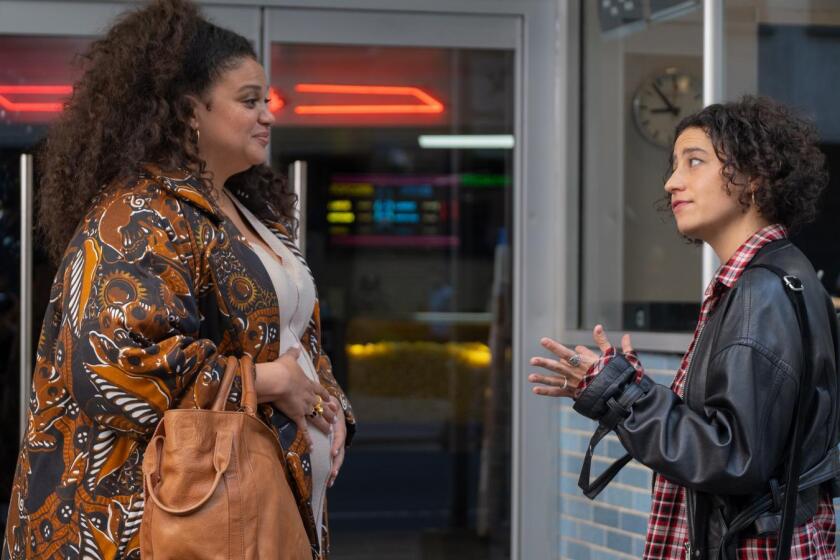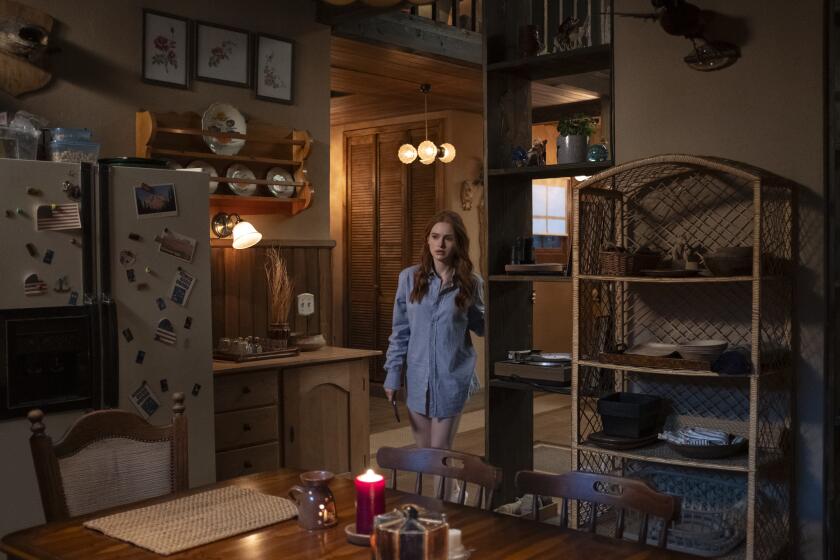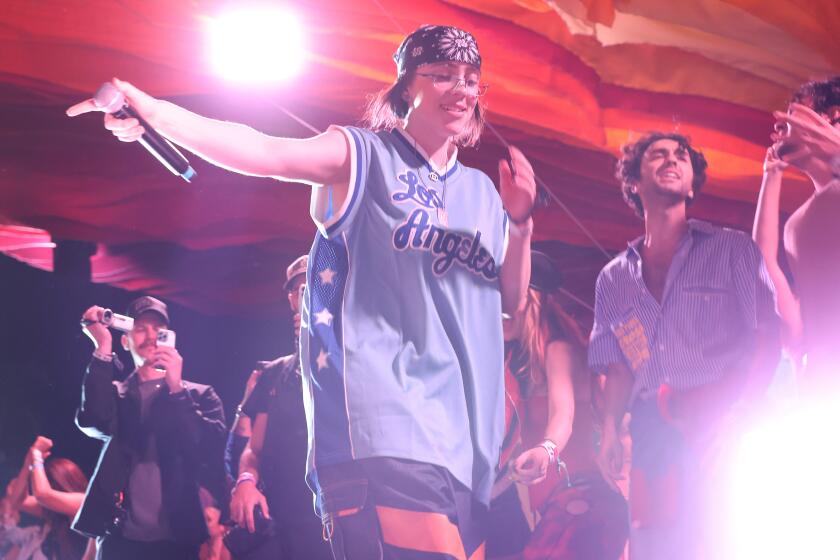If You Can’t Join’Em, Boss ‘Em Around . . . and Imitate Them
The guy standing on the corner of Wilshire Boulevard and Rodeo Drive is all that. Hawaiian shirt, convertible cargo pants, silver wraparounds, Razor scooter--a portrait of Generation Y.
Except he’s 40 if he’s a day.
Watching him, it is almost impossible to argue against the influence teenagers have on American culture. Never has a generation been so scrutinized so early by so many. From the moment they could lisp “Mighty Morphin Power Rangers,” they have been poked and prodded relentlessly by an army of marketing analysts desperate to cash in on the next merchandising trend. Any move they make, including toward a real counterculture--the Riot Grrrls, ‘zines, raves--is jotted down and within a week has a corporate sponsor.
The retail and entertainment industries pant over their numbers: 30 million teenagers wielding $122 billion in purchasing power. Only 16% of the total population, they buy 25% of the movie tickets, and 71% of teens have bought at least one CD in the last three months. Start-up networks like Fox and the WB consider teens their bread and butter, luring them with age-targeted dramas including the now-iconic “Dawson’s Creek” and “Felicity.”
But obsession often spawns dichotomies, and in the American zeitgeist, teens wear two masks as distinct and disturbing as the madonna/whore image women have fought for centuries. Even as they are celebrated as the increasingly autonomous uber-citizens of the millennial prosperity, they are also characterized as both endangered and dangerous, difficult to control and prone to violence.
Yes, they have their own cell phones, but they also increasingly have law-enforced curfews; yes, they have their own cyber-cafes, but those who break the law will find themselves not in Juvenile Hall but in the very adult prison system. In California, the three-strikes legislation extends to juveniles.
The recent Federal Trade Commission report chastising the entertainment industry for marketing products with violent content to children under 17 found a rapt audience. This country now views teen culture in terms of pre- and post-Columbine, when the video games, rap lyrics and Goth culture that adults had previously viewed only with distaste suddenly became public safety hazards.
Even before the 1999 Columbine school shooting, the term “super predator” had crashed into the vernacular, creating from a relative few horrific attacks an image of a new and frightening teen subspecies who raped and killed just for kicks. The media fed the frenzy with stories of teens shooting their parents, their siblings, their classmates; preteens robbing and beating and sometimes killing as well.
Tragic, yes. A trend? No. In fact, FBI reports show that since 1970 violent crime among young people nationwide has consistently dropped by as much as 40%.
Yet even as these numbers have dropped, cities large and small across the country continue to impose restrictions on teens, including curfews. In parts of Southern California, teens under 18 are not allowed to drive without an adult. Many schools now require uniforms--and no matter how derelict the high school, there will always be a dress code. The rising price and competition for college admission has equaled the decline in quality of secondary education, yet the public outcry over violence in the classroom matches the focus on lack of learning.
“It really is two very different things,” says David Blankenhorn, director of the Institute for American Values in New York. “On the one hand, teens are in the driver’s seat when it comes to pop culture, but then you look at public policy, and it’s very different--we want to make sure they wear their uniforms. . . . What I find very troubling is trying children as adults, which seems very harsh and punitive.”
According to Enola Aird, director of the institute’s Motherhood Project, this may be more of a continuum than a contradiction. “We want teens to be adults for our consumer purposes,” she says. “We want to liberate them from their parents so they will make their own choices, so we cultivate rebellion. But then they are liberated, and suddenly you have something that is uncontrollable. And so we are suddenly afraid.”
Fear of Free-Wheeling Youths Goes Way Back
The fear of young people, especially young people en masse, is not a new thing.
“The custom of permitting boys to ramble about the streets by night is productive of the most serious and alarming consequences to their morals,” wrote one Philadelphia journalist in 1791. “Assembled in corners and concealed from every eye, they can securely indulge themselves in mischief of every kind.”
For as long as there have been juveniles, adults have railed against juvenile delinquency--it continues to be one of the few issues uniting the political left and right. And young people do commit crimes, often heinous ones: In 18th century America, children as young as 12 were hanged for murder, jailed for theft, arson and assault.
What is new is the seeming disconnection between the adult desire to be like teens--to dress like them, to listen to their music, to adopt their slang--and the adult need to crack down on the behavior of teens.
According to Bill Strauss, co-author with Neil Howe of the newly published “Millennials Rising: The Next Great Generation” (Vintage Books), today’s teens are being punished for the problems of previous generations--drug use and crime among boomers, cynicism among Gen Xers.
“Never before has there been a generation that is less violent, less vulgar, less sexually charged than the culture being offered them,” he says. “Yet that is what is happening. The ‘teen culture’ is actually created by 20- and 30-year-olds who have little or no contact with actual teens, and they’re getting it wrong. This is the best-behaved generation in years.”
Strauss and others believe that adults often project onto teens their own foibles, and then attempt to correct them. “My favorite statistic from the ‘Millennials’ is that the death from substance abuse is one-tenth that of people in their 40s,” says Strauss. “What we need is a youth committee on adult drug abuse, not the other way around.”
“Baby boomers have a hard time with three things,” says Mike Males, author of “Framing Youth: 10 Myths About the Next Generation” (Common Courage Press, 1999). “Crime, drugs and . . . keeping families together. Only no one will admit this. But problems among them are so bad that kids have had to devise their own solutions. They’ve retreated from the grown-up world, and this scares us. But what we’re really afraid of is that the youth culture is mimicking us.”
The anger that older generations fear from young people, he says, is in actuality coming from the adult world. “There is much more of a punishing hostility toward teens today,” says Males. “In the ‘50s there was not a lot of public sentiment for locking up and executing young people. There was more of a sentiment for finding school programs to help them, for funding such programs.”
“Are we taking a social problem and projecting it onto teens--who aren’t part of the political conversation and who, by the way, just got here?” asks Blankenhorn. “That seems awfully convenient.”
Economics Changed View of Pre-Adulthood
The term “teenager” didn’t even exist before World War II. According to Thomas Hine, author of “The Rise and Fall of the American Teenager” (Avon, 1999), the concept of a person who is no longer a child but not yet an adult--and therefore governed by a special set of social and legal rules--was the creation of economics more than anything. As this country moved away from its agrarian roots to an industrialized, service-industry economy, adolescence was extended beyond its biological parameters--girls were no longer expected to marry as early, boys did not assume the duties of adulthood as young.
Universal education, which increasingly includes four years of college, pushes the age at which one is considered an adult further and further back. Meanwhile, Hine contends, young people are almost exclusively in the company of their peers, creating a distinct culture and enforcing an “us” and “them” mentality.
“Money plays an apparently paradoxical role in youth culture,” Hine writes. “[Marketing to teens] depends on young people’s isolation from the adult world. If young people had access to adult jobs and responsibilities, they would have more money, but they would become a less distinct market.”
If the teens of the 1950s, with their bobby socks and hot rods and devotion to rock ‘n’ roll, made the teen culture real, the next generation made it mythic. The baby boomers were the ultimate teenagers--underwritten by their parents and a generous government, they made rebellion a way of life and did not stop until the counterculture was the culture.
Which makes this current narrow-eyed suspicion of teens slightly ironic--the generation that vowed never to trust anyone over 30 is now enforcing curfews and checking IDs of anyone under 20. “The generation that demanded unconditional amnesty,” says Strauss, “now has zero tolerance.”
Parenting Tends to Turn People Conservative
Not that all the intentions are bad. According to polls and other research, Blankenhorn says, people tend to become more conservative when they become parents. “That’s just a fact. Because it’s one thing if you’re putting yourself at some kind of risk; it’s another if it’s your child.”
“We all suffer immediate amnesia when our kids hit adolescence,” says Mary Kay Blakely, author of “American Mom” (Algonquin, 1994) and a journalism instructor at the University of Missouri at Columbia. The fact that the boomers are turning out to be as strict, or stricter, than their parents may be a matter of envy rather than fear, she says.
“We have never felt like grown-ups, and we are absolutely fighting age tooth and nail. My generation has no experience in moving over, it’s always been the biggest,” Blakely says.
“Adult anger at teenagers is proportional to our anger at getting old,” agrees Males. “It makes us furious that teens can do so many things so effortlessly, that they have such flat stomachs.”
The Internet is one of those things teens seem to do so effortlessly, and it is arguably the most significant demarcation between generations in the history of the world. According to the Motherhood Project’s Aird, the only thing that concerns parents more than the commercial exploitation of children is the impact of technology.
“It is changing the experience of childhood,” Aird says. “All the traditional boundaries that protected children from the adult world are coming down.” Indeed, Hine argues, this is one reason the concept of the teenager as an adult-in-waiting has become obsolete. They are not waiting for anything. Teenage entrepreneurs are no longer a People magazine oddity, and many companies are following Microsoft’s example and hiring consultants right out of high school.
“Not only are we being bumped off the demographic map,” says Blakely, but teens are “bringing along a culture that we know diddly-squat about. It’s unseemly. We can’t hand them the baton, they already have the baton. They’re inventing the baton.”
Using the Internet as a Scapegoat
Blaming the Internet for teen alienation and all the perceived ills that it spawns is part of what Males calls the war against kids. “The culture wars are just a smoke screen,” he says. While there has been no proof that video games cause crime among juveniles, “there is plenty of evidence that shows a relationship between poverty and crime. So why aren’t we talking about that instead? Because it’s easier to slap on restrictions and check IDs.”
The debates over the content of movies or Internet sites have much more to do with money than with poverty. Because even the sense that teens rule pop culture is a bit illusory--they rule what they can pay for. Their tastes and preferences matter only in proportion to their cash flow.
That, says Blankenhorn, is probably more harmful than any video game. “What does impact children is the invasion of the marketplace, the idea that you can purchase your identity,” he says. “There’s nothing wrong with a market economy, but a market society is another thing.”
According to authors Strauss and Howe, the millennial teens are in fact more like their 1950s counterparts--civic-minded, honorable, personally decorous--than they are like the boomers who are regulating them. But, Strauss says, every generation has its own shadow.
“There’s always a risk,” he says. “If we keep trying so hard to standardize them, if we protect them to the point of swaddling, if we keep rewarding conformity, we could create a generation that could take technology and use it in an Orwellian sense. We don’t want unquestioning soldiers; unquestioning soldiers followed Hitler and Stalin.”
It’s time, he says, for the boomers to back off. To give the kids some credit.
*
Mary McNamara can be reached at mary.mcnamara@latimes.com.
More to Read
The biggest entertainment stories
Get our big stories about Hollywood, film, television, music, arts, culture and more right in your inbox as soon as they publish.
You may occasionally receive promotional content from the Los Angeles Times.







